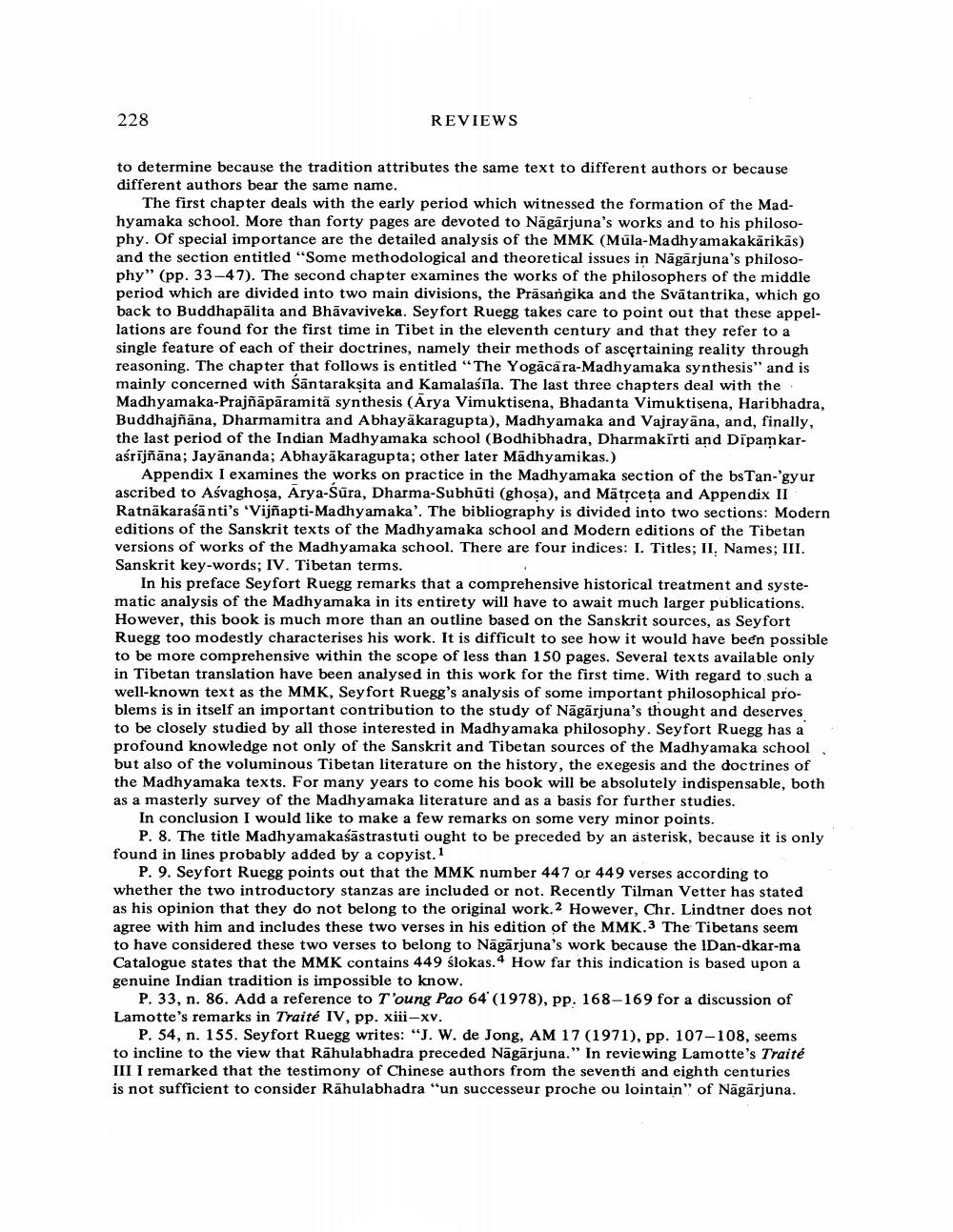________________
228
REVIEWS
to determine because the tradition attributes the same text to different authors or because different authors bear the same name.
The first chapter deals with the early period which witnessed the formation of the Madhyamaka school. More than forty pages are devoted to Nagarjuna's works and to his philosophy. Of special importance are the detailed analysis of the MMK (Mula-Madhyamakakarikās) and the section entitled "Some methodological and theoretical issues in Nagarjuna's philosophy" (pp. 33-47). The second chapter examines the works of the philosophers of the middle period which are divided into two main divisions, the Prasangika and the Svātantrika, which go back to Buddhapalita and Bhāvaviveka. Seyfort Ruegg takes care to point out that these appellations are found for the first time in Tibet in the eleventh century and that they refer to a single feature of each of their doctrines, namely their methods of ascertaining reality through reasoning. The chapter that follows is entitled "The Yogacara-Madhyamaka synthesis" and is mainly concerned with Santarakṣita and Kamalasila. The last three chapters deal with the Madhyamaka-Prajñāpāramitā synthesis (Arya Vimuktisena, Bhadanta Vimuktisena, Haribhadra, Buddhajñāna, Dharmamitra and Abhayäkaragupta), Madhyamaka and Vajrayana, and, finally, the last period of the Indian Madhyamaka school (Bodhibhadra, Dharmakirti and Dipankaraśrījñāna; Jayānanda; Abhayākaragupta; other later Madhyamikas.)
Appendix I examines the works on practice in the Madhyamaka section of the bsTan-'gyur ascribed to Asvaghosa, Arya-Śūra, Dharma-Subhuti (ghosa), and Mätṛceța and Appendix II Ratnakaraśānti's 'Vijñapti-Madhyamaka'. The bibliography is divided into two sections: Modern editions of the Sanskrit texts of the Madhyamaka school and Modern editions of the Tibetan versions of works of the Madhyamaka school. There are four indices: I. Titles; II, Names; III. Sanskrit key-words; IV. Tibetan terms.
In his preface Seyfort Ruegg remarks that a comprehensive historical treatment and systematic analysis of the Madhyamaka in its entirety will have to await much larger publications. However, this book is much more than an outline based on the Sanskrit sources, as Seyfort Ruegg too modestly characterises his work. It is difficult to see how it would have been possible to be more comprehensive within the scope of less than 150 pages. Several texts available only in Tibetan translation have been analysed in this work for the first time. With regard to such a well-known text as the MMK, Seyfort Ruegg's analysis of some important philosophical problems is in itself an important contribution to the study of Nagarjuna's thought and deserves to be closely studied by all those interested in Madhyamaka philosophy. Seyfort Ruegg has a profound knowledge not only of the Sanskrit and Tibetan sources of the Madhyamaka school but also of the voluminous Tibetan literature on the history, the exegesis and the doctrines of the Madhyamaka texts. For many years to come his book will be absolutely indispensable, both as a masterly survey of the Madhyamaka literature and as a basis for further studies.
In conclusion I would like to make a few remarks on some very minor points.
P. 8. The title Madhyamakaśāstrastuti ought to be preceded by an asterisk, because it is only found in lines probably added by a copyist.1
P. 9. Seyfort Ruegg points out that the MMK number 447 or 449 verses according to whether the two introductory stanzas are included or not. Recently Tilman Vetter has stated as his opinion that they do not belong to the original work.2 However, Chr. Lindtner does not agree with him and includes these two verses in his edition of the MMK.3 The Tibetans seem to have considered these two verses to belong to Nagarjuna's work because the IDan-dkar-ma Catalogue states that the MMK contains 449 slokas.4 How far this indication is based upon a genuine Indian tradition is impossible to know.
P. 33, n. 86. Add a reference to T'oung Pao 64 (1978), pp. 168-169 for a discussion of Lamotte's remarks in Traité IV, pp. xiii-xv.
P. 54, n. 155. Seyfort Ruegg writes: "J. W. de Jong, AM 17 (1971), pp. 107-108, seems to incline to the view that Rahulabhadra preceded Nagarjuna." In reviewing Lamotte's Traité III I remarked that the testimony of Chinese authors from the seventh and eighth centuries is not sufficient to consider Rahulabhadra "un successeur proche ou lointain" of Nagarjuna.




